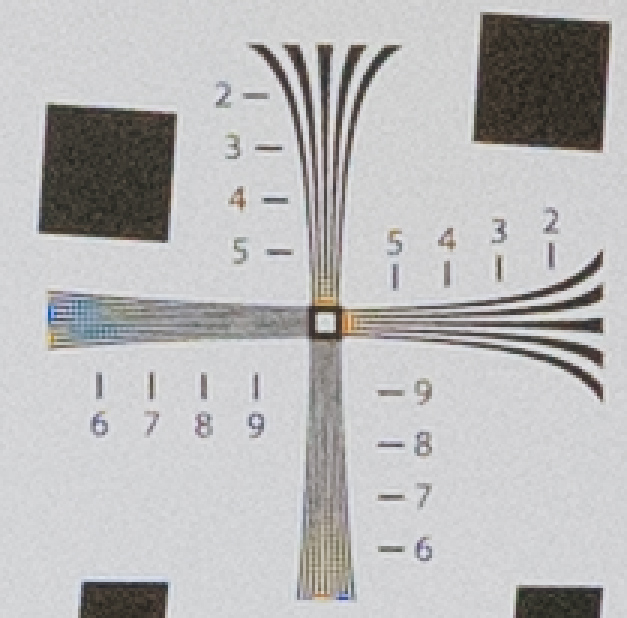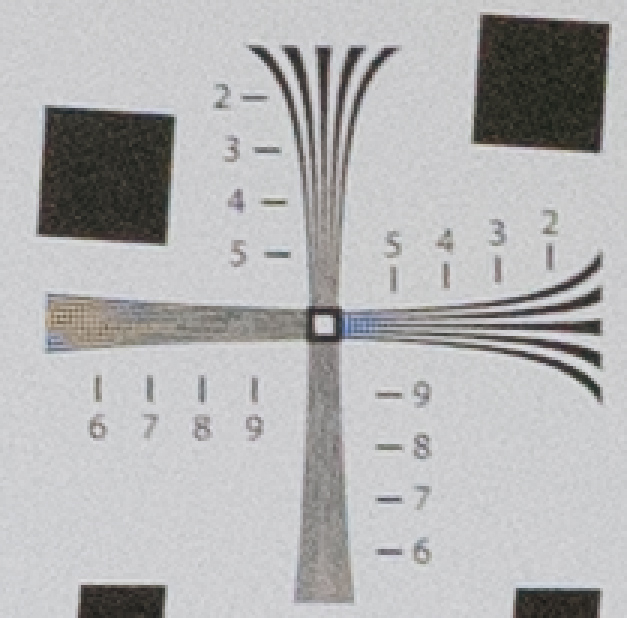Let’s take a break from the simulations to look at some real pictures. I got a 77mm Heliopan ND 0.3 to ND 1.8 variable neutral density filter and some adapter rings. I screwed the 49/77mm ring onto the Sony/Zeiss 55mm f/1.8 Sonnar FE and aimed it at the ISO 12233 target, which ended up being a bit smaller in the frame than it was with the 58mm f/1.4 Nikkor of a couple of posts back. I used a RRS TVC-34L Versa Series 3 tripod with an Arca Swiss Cube head and a generic RRS plate directly attached to the a7R.
Here’s the whole image:
I made some series at the same f-stop and shutter speeds from 1/500 to 1/15. Here’s how I did it.
- I set the filter for minimum absorption
- I opened the lens to f/1.8.
- I focused manually
- I set the exposure mode to A
- I set the f-stop to the desired f-stop
- I set the ISO so that the shutter speed read 1/500
- I made an exposure with a 2-second self-timer delay
- I set the filter so that the shutter speed got 1/3 stop longer
- If the shutter speed was faster than 1/15 second, I went to step 7
As an aside, it was much easier to focus the 55mm FE by wire than the 58mm Nikkor with a mechanical connection.
I brought the raw files into Lightroom, made no adjustments from the Adobe defaults, and exported them as layers to Photoshop. That got me a 16-layer file. I labeled the layers by shutter speed so I wouldn’t’ get confused. I added a white-balance-correcting adjustment layer on top. Then I pixel-peeked.
Here’s what I found for the series at f/5.6 with ISO 2000 in open shade on a cloudy day (I’d have liked it brighter):
- 1/500 is the sharpest shutter speed.
- 1/400 is the next best, equaling 1/500 in the sharpness of horizontal lines, but falling behind in the sharpness of vertical lines.
- 1/320 is about the same as 1/400
- At 1/250 we start to see some softening of horizontal lines, and a little bit more in the verticals.
- 1/200 shows similar degradation over 1/250 as 1/250 did over 1/320.
- 1/160 is about the same for horizontal lines but a hair worse for verticals.
- 1/125 is about the same for horizontals but worse in the verticals.
- 1/100 is about the same for horizontals but worse in the verticals.
- 1/80 is about the same for vertical but worse in the horizontals.
- 1/60 is about the same for horizontals but better in the verticals.
- 1/50 is about the marginally better in the horizontals but marginally worse in the verticals.
- 1/40 is about the same in the horizontals but marginally better in the verticals.
- 1/30 is a little better in both
- 1/25 is a little better in both
- 1/20 is a maybe a tad better in both
- 1/15 is a just a tiny bit better in both, giving about the same sharpness as 1/200.
I’m not going to post 16 jpegs that are nearly all alike, so here’s the best (1/500), blown up 3x with nearest neighbor:
And the worst (1/80):
You will note that the differences aren’t all that striking, and that they’re mostly in the vertical lines, although the shutter is moving parallel to those lines. I’m thinking that’s because the tripod is stiffer up and down than side to side, and expect when we look at pictures of the ISO 12233 target with the camera in portrait mode, we’ll see nearly all the motion parallel to the ground, as the shutter will be moving in the direction to which the tripod has the least resistance.
If anyone want to see the Photoshop file with all the layers, contact me (menu item at the top of the right-hand column) and I’ll oblige.
Future work will involve making images in bright light for greater resolution, and, if I can, making high-shutter-speed images with the filter set to 5-stop differential absorption to make sure it’s not degrading sharpness itself.



Leave a Reply